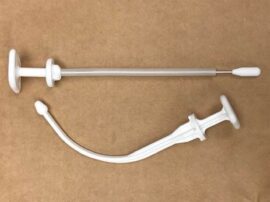For centuries, medical equipment was manufactured from one particular substance.
Metal.
The reason? Metal was often cheap, plentiful and could be molded into the various shapes required by healthcare providers of the day. Plus, you could wash and sterilized them. (When that became a thing in the 20th century.)
But then a process called “plastic injection molding” was invented by American inventor John Wesley Hyatt in 1868. While certainly a breakthrough, it wasn’t until 1946, when American inventor James Watson Hendry built the first screw injection machine, that plastic injection molding became a viable method for producing medical devices.

Why? The screw injection molding machine allowed much more control over the speed and quality of the plastics injection molding process. This machine also allowed material to be mixed before injection, so that colored or recycled plastic could be added to the initial plastic resin to produce a rainbow of colors. To this day, screw injection machines comprise the vast majority of all injection machines used by plastic injection molding companies.
What does all this have to do with plastic injection molded medical devices? Because medical devices often need to come in all kinds of shapes that don’t involve right angles. Can metal also be formed in odd shapes? Yes, but at greater cost and fewer shapes than plastic. And the ability to “color code” entire plastic devices, or parts of those devices, is also important. (Colorizing metal is much more problematic.)
There are some restrictions when using plastic for medical devices: plastic medical devices have to use FDA-approved “medical grade plastics, ” which are characterized by their ability to be used for long-periods of time and able to withstand the high temperature of frequent sterilization cycles. (And, precisely because they’re not metal, they’re corrosion-proof.)
Simply put, the typical medical plastic injection molding process is cost-efficient, flexible and ideal for high volume production runs and applications requiring product consistency and exacting tolerances.
And that’s just what the doctor ordered!